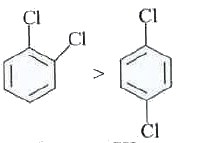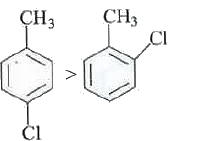Which is correct ?
Ionic mobility in aqueous medium
→Li+<Na+<K+<Rb+
Covalant character
→KCl>CaCl2>AlCl3>SnCl4
Boiling point order →H2O>H2Te>H2S
Dipole-dipole attraction →KCl+H2O
The correct Answer is:A
To determine which statement is correct among the given options, we will analyze each statement step by step.
Step 1: Analyze Ionic Mobility
1. Statement 1: The order of ionic mobility in aqueous solution is given as:
- Li⁺ > Na⁺ > K⁺ > Rb⁺
Analysis:
- Ionic mobility is influenced by the size of the ion and its hydration energy.
- As we move down the group of alkali metals (Li, Na, K, Rb), the size of the ions increases.
- Larger ions have lower hydration energy because they have a lower charge-to-size ratio.
- Therefore, Li⁺, being the smallest, has the highest hydration energy and the lowest ionic mobility.
- The correct order of ionic mobility should be:
- Rb⁺ > K⁺ > Na⁺ > Li⁺
Conclusion: Statement 1 is incorrect.
Step 2: Analyze Covalent Character
2. Statement 2: The order of covalent character is given as:
- KCl < CaCl₂ < AlCl₃ < SnCl₂
Analysis:
- Covalent character increases with the charge and decreases with the size of the cation.
- K⁺ is larger than Ca²⁺, Al³⁺, and Sn⁴⁺, which means KCl should have the least covalent character.
- As the charge increases (Ca²⁺ to Al³⁺ to Sn⁴⁺), the covalent character should increase.
- The order presented does not reflect this trend.
Conclusion: Statement 2 is incorrect.
Step 3: Analyze Boiling Points
3. Statement 3: The order of boiling points is given as:
- H₂O > H₂Te > H₂S
Analysis:
- Boiling points are influenced by intermolecular forces.
- H₂O has strong hydrogen bonding, leading to a high boiling point.
- H₂Te and H₂S have weaker van der Waals forces, but H₂Te is heavier than H₂S, which typically results in a higher boiling point due to increased mass.
- Therefore, the correct order should be:
- H₂O > H₂Te > H₂S
Conclusion: Statement 3 is correct.
Step 4: Analyze Dipole-Dipole Interaction
4. Statement 4: The interaction between KCN and H₂O is described as dipole-dipole attraction.
Analysis:
- KCN dissociates into K⁺ and CN⁻ ions in water.
- The interaction between ions and polar molecules like water is termed ion-dipole interaction, not dipole-dipole.
Conclusion: Statement 4 is incorrect.
Final Conclusion
- The only correct statement among the four provided is Statement 3 regarding boiling points.
1. Statement 1: The order of ionic mobility in aqueous solution is given as:
- Li⁺ > Na⁺ > K⁺ > Rb⁺
Analysis:
- Ionic mobility is influenced by the size of the ion and its hydration energy.
- As we move down the group of alkali metals (Li, Na, K, Rb), the size of the ions increases.
- Larger ions have lower hydration energy because they have a lower charge-to-size ratio.
- Therefore, Li⁺, being the smallest, has the highest hydration energy and the lowest ionic mobility.
- The correct order of ionic mobility should be:
- Rb⁺ > K⁺ > Na⁺ > Li⁺
2. Statement 2: The order of covalent character is given as:
- KCl < CaCl₂ < AlCl₃ < SnCl₂
- Covalent character increases with the charge and decreases with the size of the cation.
- K⁺ is larger than Ca²⁺, Al³⁺, and Sn⁴⁺, which means KCl should have the least covalent character.
- As the charge increases (Ca²⁺ to Al³⁺ to Sn⁴⁺), the covalent character should increase.
- The order presented does not reflect this trend.
3. Statement 3: The order of boiling points is given as:
- H₂O > H₂Te > H₂S
- Boiling points are influenced by intermolecular forces.
- H₂O has strong hydrogen bonding, leading to a high boiling point.
- H₂Te and H₂S have weaker van der Waals forces, but H₂Te is heavier than H₂S, which typically results in a higher boiling point due to increased mass.
- Therefore, the correct order should be:
- H₂O > H₂Te > H₂S
4. Statement 4: The interaction between KCN and H₂O is described as dipole-dipole attraction.
- KCN dissociates into K⁺ and CN⁻ ions in water.
- The interaction between ions and polar molecules like water is termed ion-dipole interaction, not dipole-dipole.
Conclusion: Statement 4 is incorrect.
- The only correct statement among the four provided is Statement 3 regarding boiling points.
Topper's Solved these Questions
- CHEMISTRY AT A GLANCEBOOK - ALLENCHAPTER - CHEMISTRY AT A GLANCEEXERCISE - ORGANIC CHEMISTRY
472 Videos
- CHEMISTRY AT A GLANCEBOOK - ALLENCHAPTER - CHEMISTRY AT A GLANCEEXERCISE - ORGANIC CHEMISTRY
472 Videos
- Chemical EquilibriumBOOK - ALLENCHAPTER - Chemical EquilibriumEXERCISE - All Questions
30 Videos
- ELECTROCHEMISTRYBOOK - ALLENCHAPTER - ELECTROCHEMISTRYEXERCISE - EXERCISE -05 [B]
38 Videos
Similar Questions
Knowledge Check
Which are correct regarding boiling point?
A B
B C
C D
D
Which is not correct?
AUGG codes for tryptophanBUAA codes for lysineCCysteine is coded by UGU and UGCDTyrosine is coded by UAU and UAC
